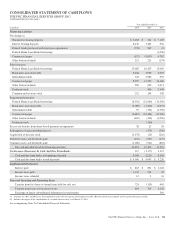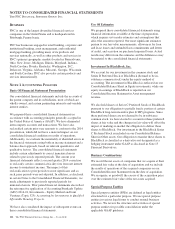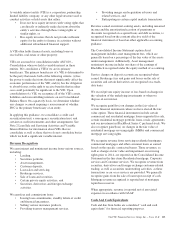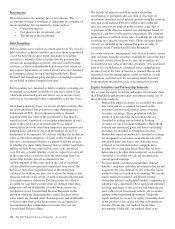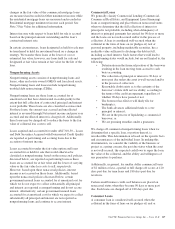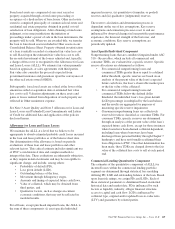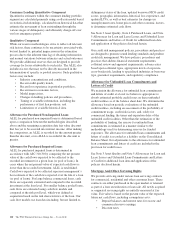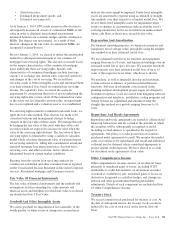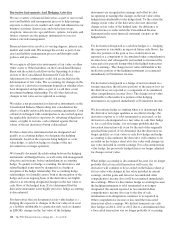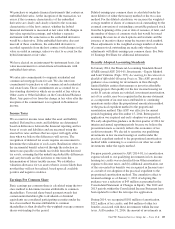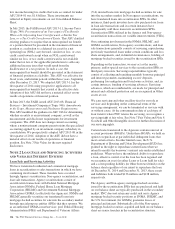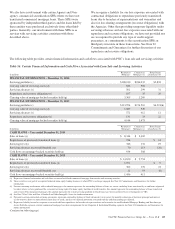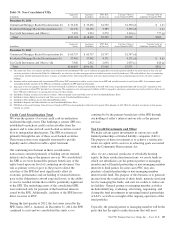PNC Bank 2014 Annual Report Download - page 136
Download and view the complete annual report
Please find page 136 of the 2014 PNC Bank annual report below. You can navigate through the pages in the report by either clicking on the pages listed below, or by using the keyword search tool below to find specific information within the annual report.personal property, including marketable securities, has a
realizable value sufficient to discharge the debt in full,
including accrued interest. Home equity installment loans and
lines of credit, whether well-secured or not, are classified as
nonaccrual at 90 days past due. Well-secured residential real
estate loans are classified as nonaccrual at 180 days past due.
In addition to these delinquency-related policies, a consumer
loan may also be placed on nonaccrual status when:
• The loan has been modified and classified as a TDR, as
further discussed below;
• Notification of bankruptcy has been received and the loan
is 30 days or more past due;
• The bank holds a subordinate lien position in the loan and
the first lien loan is seriously stressed (i.e., 90 days or
more past due);
• Other loans within the same borrower relationship have
been placed on nonaccrual or charge-offs have been
taken on them;
• The bank has repossessed non-real estate collateral
securing the loan; or
• The bank has charged-off the loan to the value of the
collateral.
Most consumer loans and lines of credit, not secured by
residential real estate, are charged off after 120 to 180 days
past due. Generally, they are not placed on nonaccrual status
as permitted by regulatory guidance.
Home equity installment loans, home equity lines of credit,
and residential real estate loans that are not well-secured and
in the process of collection are charged-off at no later than 180
days past due to reduce the basis to the fair value of collateral
less costs to sell. In addition to this policy, the bank also
recognizes a charge-off on a secured consumer loan when:
• The bank holds a subordinate lien position in the loan and
a foreclosure notice has been received on the first lien
loan;
• The bank holds a subordinate lien position in the loan
which is 30 days or more past due with a combined loan
to value ratio of greater than or equal to 110% and the
first lien loan is seriously stressed (i.e., 90 days or more
past due);
• The loan is modified or otherwise restructured in a
manner that results in the loan becoming collateral
dependent;
• Notification of bankruptcy has been received within the
last 60 days and the loan is 60 days or more past due;
• The borrower has been discharged from personal liability
through Chapter 7 bankruptcy and has not formally
reaffirmed his or her loan obligation to PNC; or
• The collateral securing the loan has been repossessed and
the value of the collateral is less than the recorded
investment of the loan outstanding.
Loans where a borrower has been discharged from personal
liability in bankruptcy and has not formally reaffirmed its loan
obligation to PNC are classified as nonperforming TDRs.
These loans are charged off to reduce the basis to the fair
value of collateral less costs to sell, and any associated
allowance at the time of charge-off is reduced to zero. The
charge-off activity results in a reduction in the allowance, an
increase in provision for credit losses, if the related loan
charge-off exceeds the associated allowance, as well as a
difference in the pre-TDR recorded investment to the post-
TDR recorded investment reflected in Table 68. Collateral
values are updated annually. Subsequent declines in collateral
values are charged-off and incremental provision for credit
loss is incurred. PNC does not return these TDRs or loans to
borrowers not currently obligated to make principal and
interest payments under the restructured terms to performing
status.
Accounting for Nonperforming Assets and Other
Nonaccrual Loans
If payment is received on a nonaccrual loan, generally the
payment is first applied to the recorded investment; payments
are then applied to recover any charged-off amounts related to
the loan. Finally, if both recorded investment and any charge-
offs have been recovered, then the payment will be recorded
as fee and interest income.
Nonaccrual loans are generally not returned to accrual status
until the borrower has performed in accordance with the
contractual terms and other performance indicators for at least
six months, the period of time which was determined to
demonstrate the expected collection of the loan’s remaining
contractual principal and interest. When a nonperforming loan
is returned to accrual status, it is then considered a performing
loan.
A TDR is a loan whose terms have been restructured in a
manner that grants a concession to a borrower experiencing
financial difficulties. TDRs may include restructuring certain
terms of loans, receipts of assets from debtors in partial
satisfaction of loans, or a combination thereof. For TDRs,
payments are applied based upon their contractual terms
unless the related loan is deemed non-performing. TDRs are
generally included in nonperforming loans until returned to
performing status through the fulfilling of restructured terms
and other performance indicators for a reasonable period of
time demonstrating that the bank expects to collect all of the
loan’s remaining contractual principal and interest. TDRs
resulting from 1) borrowers that have been discharged from
personal liability through Chapter 7 bankruptcy and have not
formally reaffirmed their loan obligations to PNC and 2)
borrowers that are not currently obligated to make both
principal and interest payments under the restructured terms
are not returned to accrual status.
See Note 3 Asset Quality and Note 5 Allowances for Loan and
Lease Losses and Unfunded Loan Commitments and Letters
of Credit for additional TDR information.
118 The PNC Financial Services Group, Inc. – Form 10-K





